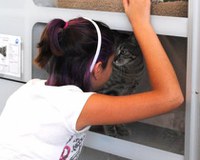Should I Adopt a Cat?

Cats are wonderful pets. They are entertaining, affectionate, and astoundingly self-reliant, making them ideal for our busy lifestyles. Studies have even shown that stroking a cat helps to relieve blood pressure. Like any pet, however, they require the proper care and a return of affection by their special humans. We encourage all potential pet owners to "Just Say Know."
Selecting the right cat for you and your lifestyle is very important. We encourage you to begin preparing for your pet before you bring it home by getting a general book about cats. There are a number of excellent books available which explain issues of cat behavior, health and training, including teaching your cat to walk on a leash.
Questions You Should Ask
- Which sex? Male and female cats both make great pets - if they are spayed or neutered. An instinct to roam and "mark" territory (urine spraying) is not limited to just male cats. In addition, female cats, if unspayed, are prone to developing life-threatening cystic ovaries or uterine infections. Spaying and neutering makes for calmer, happier cats - and owners.
- Kitten or adult? A kitten is more demanding to look after than an adult cat. Playful and inquisitive, it will need careful watching, patient training, and more human "play time." If there are already other animals in the house, kittens tend to be more adaptable and easier to introduce into the household.
- A short-hair or longhair? A short-haired cat will generally make fewer demands on your time than a long-haired cat, since its coat is less likely to mat and tangle. If you are attracted to the beauty of a long-haired cat, be prepared to spend some quality time - perhaps as often as daily- combing or brushing its coat. The amount of grooming time required for a long-haired cat varies significantly with the coat length and texture. (Tip: for removing mats from the coat, use a seam ripper rather than scissors to loosen the mat. It is much safer for you and the cat.)
- Can I commit between 5 and 20 years? Indoor cats may live on average 15 to 20 years. The average life expectancy for cats that are allowed to roam outdoors is about 5-7 years. Animal Welfare Ordinance 9-2-2-3 prohibits cats from roaming unrestrained. Hawks, owls, coyotes, and dogs commonly attack cats, severely injuring or killing them. Many cats may transmit fatal diseases when they fight for their territory. Since cats spend much of their time sleeping, they are protected and safe inside the house. Additionally, feral (wild) cats compete with and destroy native indigenous species.
Commitments
It is an important financial and emotional commitment to provide lifetime care for an animal who may live to be 20 years old. Before taking home your new cat, make sure you have committed to the following:
- Have the cat spayed or neutered as soon as possible. This is the most important commitment you can make to a cat's physical well-being.
- Make sure it receives regular veterinary care and vaccinations.
- Provide good quality, nutritionally balanced cat food.
- Always provide plenty of fresh, clean water.
- Make sure you have a scratching post available for your cat. Scratching is a natural, and needed, function of cats. Clip its nails regularly.
- Have plenty of toys available to provide mental stimulation for your cat. Since cats get bored with the same toys, you might rotate sets of toys to keep your cat interested. Paper sacks and wadded-up paper make some of the best and least expensive toys for cats.
- Provide collar and tags for your pet. Your pet must be microchipped. Microchipping is a simple, painless and safe way to ensure that your cat is returned to you, if lost.
Tips
Since cats can sometimes develop into finicky eaters, provide them a variety of foods early in their lives by adding a little canned food or cooked meat as a treat, along with a basic good quality dry food. Be careful in making changes from one type to another. Cats' digestive systems are very sensitive to rapid change. You might mix old food with the new and gradually increase the mix. Don't give milk to your cat as a substitute for water. Some cats, like people, can't digest the lactose in cow's milk. A little as a treat is okay. Make sure that food and water bowls are clean and that food and water are fresh. In multiple cat households, you may need to provide separate or multiple food and water bowls.
One of the common behavior issues with cats is inappropriate elimination. There are many books which give you guidance and tips. Cats may have to be retrained to a litter box or specific location. It takes some patience on your part. Make sure that the litter is free of feces and generally dry. Litter boxes should be accessible and in a safe place. If a cat is frightened by the location of a litter box, it won't go there. In multiple cat households, you may need to provide multiple litter boxes.
